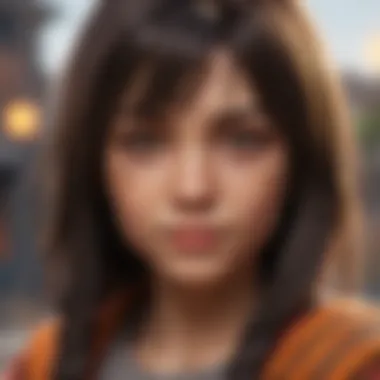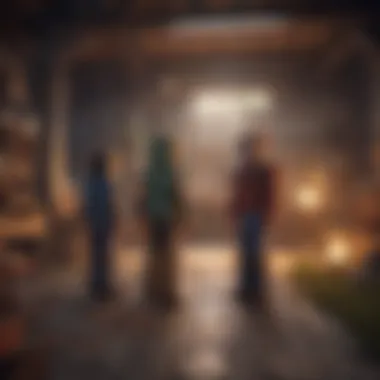Exploring Minecraft Education Skins for Engaging Learning


Intro
Minecraft has become an integral part of the educational landscape. The game's unique blend of creativity and interactivity offers significant potential for learning. Among the various elements that contribute to this educational value, Minecraft education skins play a pivotal role. These skins allow for personalization, which can enhance not only individual expression but also engagement in the learning process.
Education skins serve as digital avatars that represent players. They vary widely, from traditional educational motifs to creative designs that align with specific subjects or themes. This customization capability empowers students to connect with their in-game identities, fostering engagement and collaboration among peers. Furthermore, these skins can help educators tailor the gaming experience to fit their classroom objectives, making them a crucial tool in modern education.
In this article, we explore the significance of Minecraft education skins in enhancing educational experiences. We will delve into their customization options and how they foster a sense of identity. Ever wonder how these skins could change classroom dynamics? Let’s uncover their value in enriching student participation and creativity. Along the way, we will examine different platforms and communities contributing to educational skin development. This discussion is not only timely but vital in understanding how educational technology can be improved for the benefit of students and educators alike.
Game Feature Spotlight
Unique Gameplay Mechanics
Minecraft's gameplay mechanics allow players to build, explore, and innovate in a sandbox environment. Education skins contribute to this by providing a form of self-expression that enhances player motivation. When students see themselves as unique characters in the game, it can lead to increased investment in the tasks they undertake.
Customization here is key. Players can choose different skins that reflect personal interests or educational themes, thereby connecting their in-game presence with their real-world identity. This connection makes learning more relevant and applicable.
Art Style and Design
The design of education skins aligns with Minecraft's characteristic pixelated art style. This simplicity allows for a broad range of creative expressions without overwhelming players. Educators can select or create skins that visually represent the subject matter they are teaching, giving students a visual cue that can stimulate interest and retention.
For instance, a student learning history might choose a skin that resembles a historical figure. This not only personalizes their experience but also embeds educational content into the gaming framework.
Storyline and Characters
While Minecraft does not have a traditional storyline, the use of education skins can set the stage for narratives invented by players. When students embody characters, they can engage with topics in more meaningful ways. They might role-play historical scenarios or scientific explorations, further connecting lessons to interactive experiences.
Ultimately, the integration of customized skins into gameplay enriches students' interactions and learning potential in This digital environment.
Understanding Minecraft Education Skins
Minecraft Education Skins are a unique aspect of the Minecraft world, specifically designed to engage students in educational settings. These skins allow players to customize their avatars, making the gaming experience more personal and relatable. This personalization is crucial in educational environments where connection to one's identity can enhance learning. When students feel a sense of ownership over their avatars, it can foster a deeper level of motivation and participation in classroom activities. Understanding how these skins function and their applications widens the benefits of using Minecraft as an educational tool.
Definition and Purpose
Minecraft Education Skins are digital representations of characters within the game, created specifically for use in educational contexts. Their primary purpose is to help students express their individuality while participating in collaborative learning experiences. Through these avatars, learners can embody different roles, which makes the learning process engaging.
The definition extends beyond mere aesthetics; education skins represent a tool for educators to create a more inclusive and creative classroom. The skins facilitate conversations around various themes, whether cultural, historical, or social, thus enhancing thematic learning opportunities. Using these customized avatars, players can navigate educational scenarios with greater immersion and context.
Origin of Education Skins
The concept of education skins in Minecraft was born from the need to adapt gaming elements for educational purposes. Since its launch, Minecraft has evolved considerably, transitioning from a recreational platform to a versatile educational tool. The specific development of education skins was influenced by educators who recognized the game's potential in stimulating learning.
These skins were introduced as part of Microsoft's broader initiative to promote digital learning. They aim to make the gaming experience more relatable for students, particularly those who may feel disconnected in a traditional learning environment. As a result, these skins have become an essential part of the Minecraft Education Edition, allowing for a diverse range of avatars suitable for various subjects. Their origin reflects a significant shift in how digital spaces are leveraged for hands-on learning experiences.
The Role of Skins in Educational Settings
Minecraft education skins play a crucial role in modern educational environments. They serve not just as cosmetic features but as tools that can enhance the overall learning experience. By allowing customization, these skins create a more engaging atmosphere, promoting both individual identity and collaborative learning. Educators can leverage the appeal of these customizable avatars to foster deeper connections between students and their educational content.
Enhancing Classroom Engagement
One of the most significant benefits of using skins in educational settings is their capacity to engage students more actively. When learners use personalized avatars, they often feel a sense of ownership over their learning process. This connection can lead to increased motivation and participation. Research suggests that visually appealing elements can stimulate interest and attention in various subjects. Therefore, a well-designed skin can act as a magnet for student interaction.


In practical terms, educators can implement skins in different ways:
- Presentation of Material: Utilizing skins that represent historical figures or scientists can make lessons more immersive.
- Role-Playing Activities: Customized skins for role-playing games can deepen understanding of complex themes, such as conflict resolution or teamwork.
- Classroom Culture: Establishing classroom themes through skins can foster a sense of community and belonging among students, which is essential for social development.
Overall, the appeal of customization attracts students in a way that traditional teaching methods may not. It transforms lessons into interactive experiences, increasing retention and enthusiasm.
Fostering Creativity and Expression
Another essential aspect of Minecraft education skins is their potential to foster creativity and self-expression. Customization allows students to modify their avatars according to their preferences. This can be particularly beneficial for self-conscious students who may struggle to express their individuality in more conventional settings.
When students design their skins, they engage in a process that requires critical thinking and creativity. This can lead to:
- Artistic Development: Creating a skin involves color theory and design principles, thereby enhancing artistic skills.
- Problem-Solving Skills: Students may face challenges in the design process, which fosters problem-solving abilities as they navigate through different options.
- Peer Feedback: Sharing custom skins with classmates encourages discussions about design choices and others’ artistic visions.
Ultimately, the act of personalizing avatars can lead to higher self-esteem and confidence among learners. When students express themselves creatively through skins, they are likely to feel more invested in their educational journey.
Customizing Minecraft Education Skins
Customizing Minecraft Education Skins serves as a critical vehicle for enhancing educational experiences within the game. The customization process is not merely about aesthetic choices; it forms a vital bridge connecting learners to their avatars. Skins allow students to express their individuality while reinforcing their engagement with the learning material. By tailoring their avatars, students develop a deeper personal connection to the game, transforming a digital learning space into a personalized environment.
Available Customization Tools
Several tools are available that facilitate the customization of education skins in Minecraft. These tools cater to different skill levels and allow for various degrees of complexity. Some notable tools include:
- Minecraft Skin Editor: This is a beginner-friendly online editor. It provides a grid where users can paint their skins pixel by pixel. The interface is intuitive, making it accessible for younger students.
- Nova Skin: This tool offers advanced features such as 3D previewing and the ability to work on multiple layers. Users can import existing skins, modify them, and save their creations easily.
- Skindex: This platform not only allows users to create and edit skins but also offers a library of existing skins. Students can draw inspiration from skins created by others or start from scratch.
The availability of these tools empowers students to engage more deeply with the skin customization process, enhancing their creative and technical abilities.
Guidelines for Creating Custom Skins
When embarking on the process of creating custom skins for Minecraft Education, it's crucial to follow specific guidelines to ensure the outcomes are effective and relevant. Here are some key considerations:
- Understand the Basic Structure: Each skin is composed of multiple layers representing various body parts. Familiarizing oneself with this structure will facilitate better designs.
- Keep It Simple: Especially for beginners, starting with simple designs is advisable. Overly complex skins might diminish the effectiveness of customization.
- Consider the Audience: When creating skins, students should think about who their classmates are and what might resonate with them. This can enhance collaborative learning and discussion.
- Incorporate Educational Themes: Align skins with classroom topics. For instance, a student learning about historical figures might create a skin that reflects someone significant from that era.
- Test and Iterate: Allow time to test different designs within the game. Feedback from peers can guide students in adjusting their skins to better fit user preferences.
Creating custom skins is about more than decoration. It's an opportunity for learners to dive into creative processes and work collaboratively to foster a vibrant learning community.
"Skins provide a form of identity in Minecraft, allowing students to express their personalities in a digital environment."
This community aspect is bolstered through shared customization experiences and collaborative projects. Using these tools and adhering to these guidelines, educators and students can leverage the power of Minecraft Education skins to enhance the overall learning experience.
Impact of Skins on Student Identity
The use of skins in Minecraft education plays a significant role in how students perceive themselves within the game. It goes beyond mere aesthetics; skins can help students build a personal connection to their avatars. This personal connection has notable benefits, contributing to increased motivation and engagement in educational activities.
Building Personal Connection to Avatars
Skins allow students to express their identity and creativity. When students customize their avatars, they invest a part of themselves into the game. This process of personalization fosters a sense of ownership and belonging. For many, seeing their own unique avatar on screen can inspire confidence.
In this way, students become more connected to the learning objectives. A compelling avatar serves as a reminder of their own goals and aspirations. Additionally, this personal connection to avatars can reduce feelings of isolation. By seeing others with uniquely designed skins, students may feel encouraged to engage more actively with their peers.
Encouraging Collaborative Learning


Skins also serve an important role in promoting collaboration among students. In group activities where teamwork is crucial, having distinctive skins can help students identify their peers easily. As students work together, they can learn from each other's design choices. This exchange of ideas further enhances the collaborative aspect of learning within Minecraft.
When students see their peers express themselves through skins, it can lead to discussions about choices and preferences, fostering a culture of sharing and creativity. This atmosphere of collaboration encourages learning from one another, which is an essential component of any educational setting.
"The creative customization of skins leads to enhanced social interaction, allowing students to share ideas and build relationships in the learning environment."
In summary, the impact of skins on student identity is profound. They facilitate personal expression and promote collaboration. As students engage with their avatars, they build connections that can enhance their overall educational experience.
Platforms for Accessing Education Skins
Accessing education skins in Minecraft is essential for educators and learners alike. These platforms provide valuable resources and tools that enhance the customization experience. Understanding the available platforms allows users to integrate skins into their learning environment effectively. The role of both official and community-driven platforms is significant, each offering unique features and benefits that contribute to the overall educational experience.
Official Minecraft Marketplace
The Official Minecraft Marketplace is a primary destination for acquiring education skins. Managed by Mojang, the platform ensures a curated selection of skins specifically designed for educational use. The Marketplace offers several advantages:
- Quality Assurance: Skins available here meet specific quality standards, ensuring an optimal experience for users.
- User-Friendly Interface: The Marketplace is designed to be intuitive. This feature allows users to find educational skins quickly.
- Safety and Security: Transactions and downloads through the Marketplace are secure, providing peace of mind for educators when accessing resources.
In addition, the Marketplace often accompanies various educational content packs that include skins, ensuring that educators have everything needed at their fingertips. These packs can also seamlessly integrate into lesson plans, enriching the learning experience.
Community-Driven Platforms
In contrast, community-driven platforms like Reddit and various dedicated forums foster a collaborative environment where users can create and share their skins. These platforms offer rich opportunities for customization, including:
- Diverse Selection: Users can find a wide variety of skins created by other gamers, reflecting different cultures, themes, and styles. This variety allows individuals to express themselves uniquely.
- Collaborative Learning: Educators can collaborate with students or peers to design skins that meet specific educational goals. This collaboration fosters creativity and enhances engagement in the learning process.
- Feedback and Improvement: Community platforms often encourage feedback. This exchange can lead to improved designs and fresh ideas, enhancing the overall quality of the skins.
While community-driven platforms may lack the strict oversight of the Official Marketplace, they provide essential avenues for creativity and customization in the realm of Minecraft education.
Using both types of platforms maximizes the potential of educational skins, catering both to immediate needs and personal expression.
By leveraging these platforms, educators and students can create a dynamic and engaging learning environment, transforming their classroom experiences.
Communities and Resources for Skins Development
The development of Minecraft Education skins is not a solitary pursuit; rather, it thrives within a rich ecosystem of communities and resources. This section explores the essential role these communities play and the resources they offer in enhancing the educational experience through skins customization.
First, the existence of passionate communities brings together users with varying skills and knowledge. This collective knowledge pool allows educators and players alike to share insights and tips on how to create or refine skins for educational use. The collaborative nature of these communities fosters innovation and creativity, as individuals can provide feedback on each other's designs. Such interactions can lead to the production of skins that not only appeal aesthetically but also serve specific educational purposes.
In addition, community-driven resources provide crucial support for anyone looking to develop their own skins. These resources can range from tutorials on skin creation to databases of existing skins that educators can leverage immediately. Understanding these available tools can significantly enhance the effectiveness of educational projects, empowering teachers to personalize their students' experiences in Minecraft.
Online Forums and Resource Sites
Online forums and resource sites act as hubs where aspiring developers and established creators converge. Websites like Reddit and dedicated Minecraft forums present spaces where users can ask questions, seek advice, and showcase their skins. Through threads in these forums, users can describe their vision, receive constructive criticism, and adapt their designs based on feedback from the community.
Resource sites also compile valuable tutorials and guides that can assist users in navigating the complexities of skin creation. For instance, platforms such as the Minecraft Skin Editor provide straightforward interfaces for users to create detailed custom skins without requiring extensive graphic design experience. Moreover, these resources often host galleries of user-generated skins, providing inspiration and examples of what is possible with creativity and tools at hand.
Collaborative Learning Environments
Collaborative learning environments emphasize the significance of teamwork in skin development and application. In such settings, students can work together to create skins that reflect their shared interests or concepts learned in class. This collaboration encourages communication and teamwork, essential skills in modern education.
Educators can facilitate these projects by organizing group activities centered on skin design. Such initiatives can help students reinforce their grasp of particular subjects while also honing their creativity. For instance, a history project might inspire students to create skins representing historical figures, combining art with learning.


"In an age where digital collaboration is paramount, engaging with communities is not just beneficial; it is essential for educational growth."
To explore further, consider checking these resources: Reddit, Wikipedia, and Britannica.
Through collective efforts, the customization of Minecraft skins can lead to greater student engagement and a more enriched educational environment.
Educational Frameworks and Skin Application
The integration of Minecraft education skins within various educational frameworks is crucial in enhancing the learning experience in innovative ways. These frameworks provide a structure that educators can follow to implement skins effectively in their lessons. The use of skins can foster engagement, creativity, and collaboration among students, aligning with contemporary educational goals that emphasize student-centered learning and personalization in education.
Benefits of Utilizing Skins in Education
The impact of Minecraft education skins on learning can be outlined in several key benefits:
- Personalization: Skins allow students to express their individuality. Creating or selecting a skin enables users to relate more deeply to their avatars, fostering a stronger connection with the gameplay.
- Engagement: The visual aspect of skins can attract students’ attention, making learning more appealing. Well-designed skin applications can motivate students to participate actively in class activities.
- Interdisciplinary Learning: Skins can be integrated into various subjects like history, science, and arts. By relating skin customization to real-world themes and characters, educators can create a multifaceted learning experience.
Considerations When Implementing Skins
However, it is important to acknowledge certain factors when considering the application of skins in educational contexts. Educators should be aware of:
- Diverse Learning Styles: Understanding that each student may have a different preference in appearance and representation is essential. Skins should cater to a range of tastes and identities.
- Cultural Sensitivity: Educators need to ensure that skins used in educational settings respect cultural representations and avoid stereotypes that may alienate some students.
- Technology Accessibility: Not all students may have access to the online resources necessary for skin customization. Ensuring equal access is essential in fostering an inclusive learning atmosphere.
Integration in Various Subjects
Integrating Minecraft education skins across different subjects can significantly enhance the curriculum. For instance, history lessons can incorporate historical figures as skins, allowing students to inhabit the roles of renowned personalities. In science classes, skins might represent various careers opportunities, like a scientist or environmentalist, making the subject matter more relatable.
Examples of Integration
- History: Students can create skins based on specific historical periods, facilitating discussion about lifestyle, fashion, and culture during those times.
- Mathematics: Skins that highlight geometric shapes and concepts can be created, helping students visualize problems and understand abstract concepts.
- Art: Students can use skins as a canvas to express their creative abilities, promoting artistic skills alongside digital literacy.
This approach helps students draw connections between topics and encourages them to view learning as interconnected rather than isolated subjects.
Case Studies of Successful Implementation
Examining cases where Minecraft education skins have been successfully implemented can provide valuable insights for educators. Teachers have reported noteworthy outcomes from adopting these skins in their classrooms.
For example, a school district in the Midwest incorporated Minecraft with unique skins related to environmental science lessons. Students designed skins based on endangered species, and they used these avatars in a corresponding game environment that simulated various ecosystems. This not only bolstered learning about biodiversity but also raised awareness on conservation efforts.
"Engagement through personalized skins can lead to a deeper understanding of subject matter and encourage students to take ownership of their learning."
Another case study from a high school highlighted the use of themed skins during project-based learning sessions. Students represented themselves through innovative skins that reflected their research on various global cultures, enhancing peer interactions and collaborative projects.
In summary, the application of educational frameworks to skin integration requires thoughtful planning and execution. Through interdisciplinary teaching and reflection on successful case studies, educators can leverage Minecraft education skins to create rich, engaging learning environments.
Future Trends in Minecraft Education Skins
As we look towards the future, the significance of understanding trends in Minecraft education skins becomes increasingly apparent. Education in the digital age is shifting rapidly. Gamification, personalized learning, and interactive experiences are becoming cornerstones of modern pedagogy. As a result, the customization of education skins in Minecraft is evolving to meet these demands. The primary advantage lies in enhancing the educational experience for students and educators alike. By focusing on future trends, we can identify emerging possibilities and avoid potential pitfalls in educational gaming.
Predicted Evolution of Educational Gaming
The landscape of educational gaming is predicted to evolve considerably in the coming years. Trends indicate a move towards hyper-personalized learning experiences. In this context, education skins will play a pivotal role. Educators will increasingly have the means to tailor these avatars, allowing them to reflect diverse learning styles and identities. This adaptation can foster inclusivity, ensuring every student feels represented, thus promoting a positive learning atmosphere.
Innovations in game mechanics will also reshape how skins are used. For instance, skins could integrate with augmented reality, providing a more immersive environment for learning. Imagine students exploring scientific concepts while virtually embodying different scientists or historical figures, facilitated by unique skins that enhance their engagement and understanding. Moreover, as artificial intelligence improves, it may offer suggestions for skin customization based on student performance and preferences, making the learning experience even more dynamic.
Emerging Technologies in Gaming Education
With the rise of new technologies, the future of Minecraft education skins will likely see various advancements. One prevalent trend is the integration of augmented and virtual reality. These technologies will provide a richer context for educational engagement. Students could navigate virtual worlds where their avatars not only represent them but also adapt in real-time based on interactions within the ecosystem of the game.
Blockchain technology might also emerge within educational gaming frameworks. This integration can provide secure ownership of customized skins and in-game assets. Students or educators could trade or sell their unique creations, thus motivating participation in skin development while also teaching economic concepts.
Incorporating machine learning will likely enhance custom skins by assessing individual student needs. The technology can analyze gameplay data to suggest skins that align with personality traits or learning preferences. This would empower students to engage with their avatars in deeper ways.
In summary, the trends in Minecraft education skins reflect broader shifts in educational methodologies, driven by technology and the necessity for personalized learning environments. Keeping abreast of these developments ensures educators can use Minecraft effectively, enhancing the educational journey for all learners.





